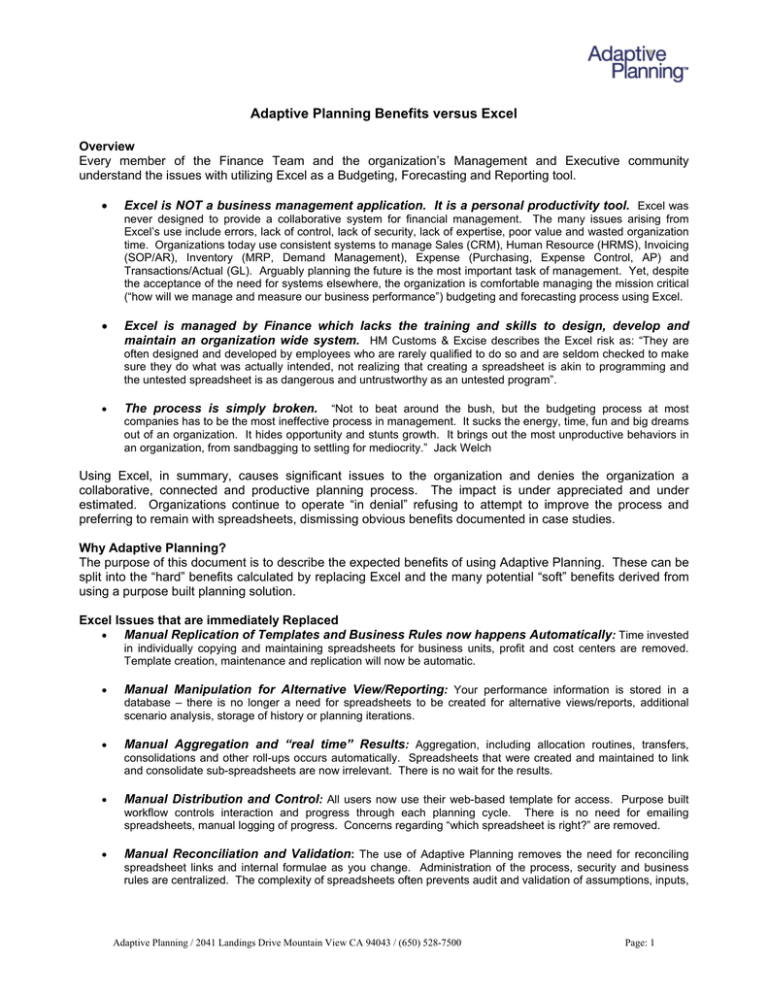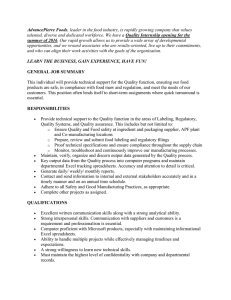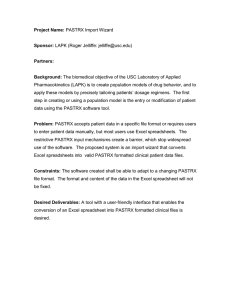Adaptive Planning Benefits versus Excel
advertisement

Adaptive Planning Benefits versus Excel Overview Every member of the Finance Team and the organization’s Management and Executive community understand the issues with utilizing Excel as a Budgeting, Forecasting and Reporting tool. • Excel is NOT a business management application. It is a personal productivity tool. Excel was never designed to provide a collaborative system for financial management. The many issues arising from Excel’s use include errors, lack of control, lack of security, lack of expertise, poor value and wasted organization time. Organizations today use consistent systems to manage Sales (CRM), Human Resource (HRMS), Invoicing (SOP/AR), Inventory (MRP, Demand Management), Expense (Purchasing, Expense Control, AP) and Transactions/Actual (GL). Arguably planning the future is the most important task of management. Yet, despite the acceptance of the need for systems elsewhere, the organization is comfortable managing the mission critical (“how will we manage and measure our business performance”) budgeting and forecasting process using Excel. • Excel is managed by Finance which lacks the training and skills to design, develop and maintain an organization wide system. HM Customs & Excise describes the Excel risk as: “They are often designed and developed by employees who are rarely qualified to do so and are seldom checked to make sure they do what was actually intended, not realizing that creating a spreadsheet is akin to programming and the untested spreadsheet is as dangerous and untrustworthy as an untested program”. • The process is simply broken. “Not to beat around the bush, but the budgeting process at most companies has to be the most ineffective process in management. It sucks the energy, time, fun and big dreams out of an organization. It hides opportunity and stunts growth. It brings out the most unproductive behaviors in an organization, from sandbagging to settling for mediocrity.” Jack Welch Using Excel, in summary, causes significant issues to the organization and denies the organization a collaborative, connected and productive planning process. The impact is under appreciated and under estimated. Organizations continue to operate “in denial” refusing to attempt to improve the process and preferring to remain with spreadsheets, dismissing obvious benefits documented in case studies. Why Adaptive Planning? The purpose of this document is to describe the expected benefits of using Adaptive Planning. These can be split into the “hard” benefits calculated by replacing Excel and the many potential “soft” benefits derived from using a purpose built planning solution. Excel Issues that are immediately Replaced • Manual Replication of Templates and Business Rules now happens Automatically: Time invested in individually copying and maintaining spreadsheets for business units, profit and cost centers are removed. Template creation, maintenance and replication will now be automatic. • Manual Manipulation for Alternative View/Reporting: Your performance information is stored in a database – there is no longer a need for spreadsheets to be created for alternative views/reports, additional scenario analysis, storage of history or planning iterations. • Manual Aggregation and “real time” Results: Aggregation, including allocation routines, transfers, consolidations and other roll-ups occurs automatically. Spreadsheets that were created and maintained to link and consolidate sub-spreadsheets are now irrelevant. There is no wait for the results. • Manual Distribution and Control: All users now use their web-based template for access. Purpose built workflow controls interaction and progress through each planning cycle. There is no need for emailing spreadsheets, manual logging of progress. Concerns regarding “which spreadsheet is right?” are removed. • Manual Reconciliation and Validation: The use of Adaptive Planning removes the need for reconciling spreadsheet links and internal formulae as you change. Administration of the process, security and business rules are centralized. The complexity of spreadsheets often prevents audit and validation of assumptions, inputs, Adaptive Planning / 2041 Landings Drive Mountain View CA 94043 / (650) 528-7500 Page: 1 calculations and outputs. Over 92% of spreadsheets have calculation errors (source: KPMG) and this risk is removed. • Security: Spreadsheets have no inherent or centrally maintained security. Proprietary and valuable business planning and performance management information is unprotected in this environment. Adaptive Planning is completely secure. • Confidence and “one version of the truth”: Use of a purpose built planning application builds confidence in the quality and accuracy of the data presented. Unlike spreadsheets, there is “one place” for all financial and operational planning and performance information. Benefits received from implementing a Purpose Built System • Participation and Frequency: The systematic approach where the existing manual processes are replaced allows greater participation and/or frequency. This may mean planning can be extended to more users deeper into the company. It may mean greater participation during the planning iterations (initial submission, fine tuning, agreement cycles). You can also now increase the frequency of planning (rolling monthly updated, “on demand” or event based forecasting, etc.). • Accountability: A systematic approach with participation by the business managers drives accountability into the business. • • Flexibility: Business operations and planning processes require great flexibility to adapt to new circumstances and demands and provide what if? modeling. Changing processes, data views, metrics or assumptions quickly and without disrupting existing data or the business users is an integral part of Adaptive Planning. Versions/Scenarios: You can now conduct multi-version planning for different business conditions in one integrated system. • System Integration: Adaptive Planning integrates data with your other systems using an easy to manage and reliable process. • Web Deployment: The users are managed via their web browser to ease the distribution and data collection and reporting processes. There is less network traffic and overhead. • Time Savings (opportunity costs): The time saved in replacing a spreadsheet-based system and the associated manual processes can be significant. Finance, Executive and Business Managers can use this time for true “value add” activities: Increase Finance’s time for analytical tasks, supporting the business operations and examining opportunities for increasing revenues, cost efficiencies and continued process improvement. Adaptive has examples of customers who, through us of Adaptive Planning, were able to dedicate finance and business time to analysis resulting in substantial savings. Typical areas such as product and customer profitability, marketing spend effectiveness, standardization and control of capital and operating expenses, increased scrutiny and business case demands for justification of new projects. Executive and Business Managers increase productive time on planning and performance discussion, preparation, review and agreement versus the actual planning process itself. Time can be reallocated to other business management tasks. • Planning Multi-dimensionality: Businesses are multi-dimensional with key dimensions of products, customers, personnel, channels all requiring integration for planning and performance measurement. A purpose built system deals with these relationship complexities and planning process demands as standard. • Control: Adaptive Planning provides for centralized and controlled assumptions, drivers and KPIs. All planning can be based on using these corporate standards to ensure a consistent approach, the ability to truly measure and compare performance “apples to apples” and also drive out discretionary expenses (such as travel, temporary personnel) with greater detail and control. Strategic Business and Personnel Benefits • Adoption of “Best Practice” and High Participation Planning: Best Practice systems and methodology approach drives considerable benefit through accountability, participation and increasing Adaptive Planning / 2041 Landings Drive Mountain View CA 94043 / (650) 528-7500 Page: 2 manager’s responsibility for performance. Manage and measure business performance on driver basis, KPIs, impact points and focus attention to mission critical data while avoiding information overload. • Confidence: Decision-making is based on proven, accurate and valid planning data. • Personnel: Use of enhanced systems and increased in time to “value add” activity improves morale, drives a performance based culture and ensures all management is driving towards same business goals and objectives. Focus expensive resources upon performance prediction and analysis versus mechanics and data integrity resolution. • Invest in Technology and Leverage existing Technology Investment: Investment in technology and enhanced productivity versus increased labor costs. Adaptive Planning leverages existing Excel, GL, other systems and your financial expertise to promote adoption. • Align to Corporate Strategy with Operational Efficiency: Drive corporate strategy down within the Adaptive Planning system for guidance, validation and control purposes. Improve planning cycle times (months to weeks, weeks to days, plan recomputation/realignment within hours). • Deliver Competitive Advantages to the Company: The ultimate objective is to nurture and enhance a performance driven culture. planning input, accountability and measurement in the hands of all stakeholders. You will need to ask key questions such as what is the tangible benefit of: Having one single integrated system for all performance planning? Identifying a revenue or cost trend and acting to exploit that opportunity or prevent a continuation of inefficiency? Being able to plan continuously and in real time through the planning cycle? Having increased accountability and management responsibility throughout the organization? Cost/Benefit Analysis Excel, combined with Finance and Management attitude, is the inhibitor to an organization developing an effective and valuable planning process. The option to “do nothing” is the most common choice despite acceptance of the need to change. Despite the potential value and operational benefits organizations will cite the cost of change as a reason to remain with Excel. Spreadsheets are so inefficient and costly to maintain it is easy to estimate the financial benefit of replacing Excel as a system without needing to include any “soft” benefits. The example included here describes a typical planning process. Adaptive Planning / 2041 Landings Drive Mountain View CA 94043 / (650) 528-7500 Page: 3 Adaptive Planning v Excel – Return on Investment This simple example is based upon a company of 3 Sales Channels, 25 Cost Centers, 2 Divisions and a Corporate Consolidation. The company has an Annual Budget process and prepares 3 Quarterly Forecasts totalling 4 planning cycles. Each planning cycle has 4 iterations. Involved in the process are 2 Finance personnel and 30 Executives and Line of Business Managers. Total Time 81 hours x4 planning cycles Unit Cost* $36.06 Extended Cost $11,683 3 hours per Sales Channel 1 hour per Cost Center 4 hours for each consolidation process to Division 6 hours for each consolidation process to Corporate 2 hours reconciliation to Actual and/or Prior Version 50 hours x 4 planning cycles x4 iterations $36.06 $28,846 Reporting and Analysis: Finance time for updating spreadsheets month to month for latest actuals and new analysis 20 hours per month importing/rekeying and reconciling actuals 20 hours per month manually maintaining existing spreadsheets and meeting new reporting needs with new spreadsheets 480 hours $36.06 $17,308 Executive and Management Time: Access, viewing and using the spreadsheet based system. Participation in the Budget and Forecast processes. 15 hours per Manager per cycle participating in spreadsheet distribution and data entry process 10 hours per Manager per month using spreadsheet system for business analysis and decision making 5,400 hours $36.06 $194,712 Phase Preparation: Finance time for spreadsheet preparation and maintenance for new assumptions, new business rules, import/key in updated actuals and roll ups from detail through to consolidated Financial Statements. Time 5 hours per Sales Channel 1 hour per Cost Center 8 hours per Division 15 hours for Corporate 10 hours for Reports Process Management: Finance time for spreadsheet distribution to department Managers. Includes each iteration and consolidation process. Reconcile to prior iteration. Update for new assumptions, business rules, structures and roll ups as needed during planning cycle. TOTAL COST OF CURRENT PROCESS ESTIMATED ANNUAL SAVING $252,548 Finance Time Executive and Management Time 67% 15% TOTAL ANNUAL SAVING* $38,558 $29,207 $67,764 ADAPTIVE PLANNING ANNUAL COST ** $19,970 ESTIMATED 3-YEAR RETURN ON INVESTMENT* ESTIMATED PAYBACK PERIOD 239% 11 months ESTIMATED ANNUAL SAVING AFTER IMPLMENTATION * ** $52,764 Annual cost of Staff including benefits and other costs = $75,000 ($36.06 per hour using 2,080 hours per year). Excludes “hidden costs” such as Excel storage, network impact of distributing large spreadsheets, opportunity cost of time, value of single source of planning/reporting information, value of accuracy, value of improved decision making, etc. Assumes 3-Year Subscription and Average Professional Services Cost Adaptive Planning / 2041 Landings Drive Mountain View CA 94043 / (650) 528-7500 Page: 4



